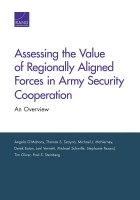| 来源类型 | Research Reports
|
| 规范类型 | 报告
|
| DOI | https://doi.org/10.7249/RR1341.1
|
| ISBN | 9780833096036
|
| 来源ID | RR-1341/1-A
|
| Assessing the Value of Regionally Aligned Forces in Army Security Cooperation: An Overview |
| Angela O'Mahony; Thomas S. Szayna; Michael J. McNerney; Derek Eaton; Joel Vernetti; Michael Schwille; Stephanie Pezard; Tim Oliver; Paul S. Steinberg
|
| 发表日期 | 2017
|
| 出版年 | 2017
|
| 页码 | 52
|
| 语种 | 英语
|
| 结论 |
The Regionally Aligned Force Concept Can Help the Army More Effectively Undertake Its Security Cooperation Missions- The alignment of the 2nd Brigade Combat Team, 1st Armored Division, to U.S. Africa Command improved the efficiency of security cooperation (SC) planning and preparation.
- The success of the regionally aligned force (RAF) concept as a process more broadly will depend on structured planning, agility, and access to appropriate personnel.
- The ability of RAF to carry out SC missions successfully will depend on planners' abilities to match SC activities to theater security objectives (TSOs) and partner-nation conditions.
- Planning and training for missions that span an entire continent entail much uncertainty and complexity. Building greater planning time and developing a structured planning process for RAF missions in Africa might improve mission effectiveness.
- RAF units experienced difficulty delivering training to partner-nation units that possessed nonstandard equipment.
- On average, U.S. Army Africa SC events were most likely to include partner nations that were most politically attractive and militarily compatible.
- Planners did a good job working within their constraints to match SC activities to TSOs and partner-nation conditions.
|
| 摘要 |
- The Army should increase use of senior-leader public comments and informal communication to better understand how to translate formal RAF guidance into execution; consider selecting one division to align permanently with each combatant command; consider assigning an infantry (not armored) brigade combat team for the RAF in Africa; add greater specificity and concrete examples to RAF guidance to help planners more effectively find personnel; identify, publicize, maintain, and catalog potential opportunities for RAF units to obtain support and to help them understand and make greater use of their options for developing cultural awareness, knowledge transfer, and other training skills; more thoroughly review readiness requirements in the context of the RAF and give clear guidance to help maintain high unit readiness while conducting SC missions; facilitate an annual RAF assessment workshop to share best practices among all Army service component commands; have each brigade combat team go through a validation exercise before deploying on an SC mission; and consider developing simpler, clearer methods to support RAF brigades with the right subject-matter experts.
- The RAF should use this planning framework to help match SC activities to TSOs and partner-nation conditions; collaborate with special operations forces to institutionalize how forces aligned within each geographic combatant command identify, plan, and prepare for missions involving nonstandard equipment; and slightly amend U.S. Army Forces Command guidance to ensure that future units consider regionally focused training and its relevance to SC early in their training.
|
| 主题 | Africa
; Military Force Deployment
; Military Force Planning
; Security Cooperation
; United States Army
|
| URL | https://www.rand.org/pubs/research_reports/RR1341z1.html
|
| 来源智库 | RAND Corporation (United States)
|
| 引用统计 |
|
| 资源类型 | 智库出版物
|
| 条目标识符 | http://119.78.100.153/handle/2XGU8XDN/108508
|
推荐引用方式
GB/T 7714 |
Angela O'Mahony,Thomas S. Szayna,Michael J. McNerney,et al. Assessing the Value of Regionally Aligned Forces in Army Security Cooperation: An Overview. 2017.
|
|
文件名:
|
x1495316830912.jpg
|
|
格式:
|
JPEG
|

|
文件名:
|
RAND_RR1341z1.pdf
|
|
格式:
|
Adobe PDF
|
除非特别说明,本系统中所有内容都受版权保护,并保留所有权利。